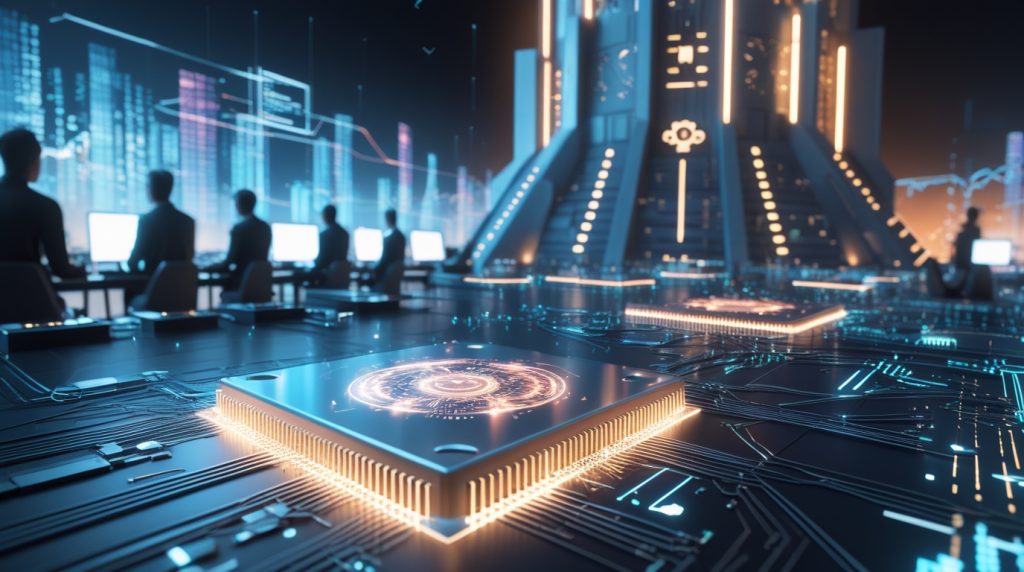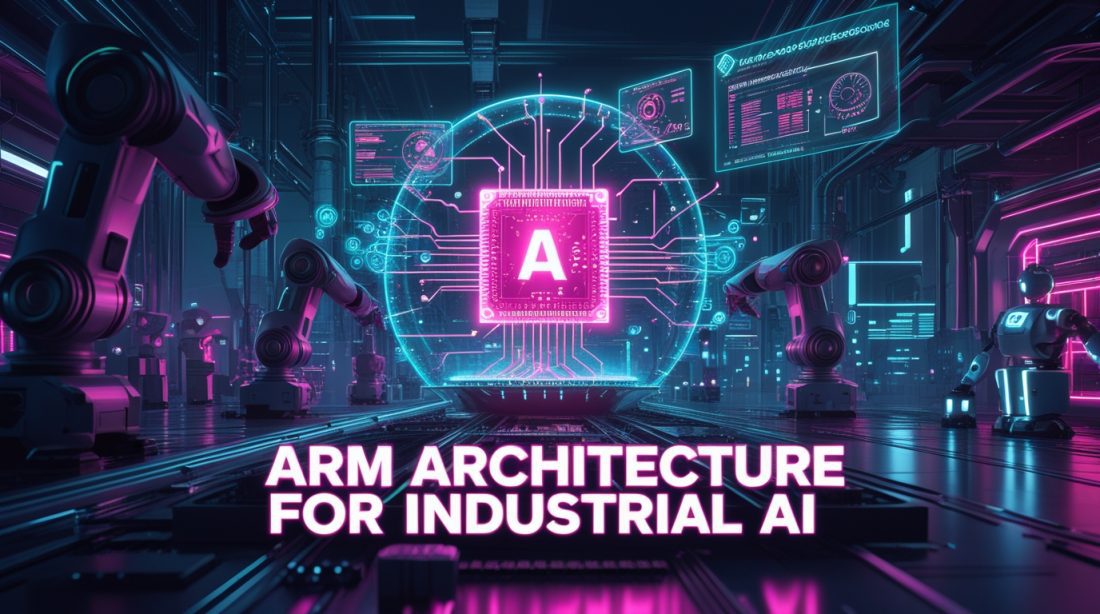In the high-stakes race for AI dominance, the most strategic moves are often the quietest.
The narrative of the AI boom has been dominated by flashy GPUs and massive data centers. Yet, a deeper, more fundamental shift is powering this transformation: the rise of efficient, specialized computing. At the heart of this shift is Arm Holdings, a company whose processor IP and licensing business is quietly becoming the bedrock of industrial AI. Increasingly, industrial leaders are betting on Arm architecture for industrial AI to deliver the computational efficiency and scalability required for the next decade. While headlines chase the next big chip, this architecture is enabling smarter, more sustainable, and more pervasive AI—from the cloud to the edge of the factory floor.
How Arm Architecture for Industrial AI Became the Backbone of Scalable, Energy-Efficient Automation
Why does a licensing model matter for industrial AI?
Arm’s core business—designing processor blueprints and licensing them to other companies—is uniquely suited to the fragmented, specialized world of industrial AI. Instead of selling one-size-fits-all chips, Arm enables a ecosystem of innovation. Companies from Amazon to NVIDIA license ARM’s IP to create custom silicon perfectly tailored to their specific AI workloads, whether for a cloud server or an autonomous vehicle’s vision system.
This model accelerates development. For an industrial company building a smart factory, designing a chip from scratch is prohibitively expensive and slow. Licensing Arm’s proven, power-efficient CPU designs allows them to focus their R&D on differentiation, not fundamental architecture. As one analyst notes, this has led to a “14-fold” increase in Arm’s data center customers since 2021, a clear indicator of the strategy’s resonance. This collaborative ecosystem is the engine behind the custom silicon boom, allowing for rapid iteration and deployment of AI-optimized hardware.
Why is power efficiency the killer feature for industrial scale?
The astronomical energy consumption of AI is one of the biggest hurdles to its widespread industrial adoption. Arm’s architecture provides a critical advantage here. The company points out that its designs can make AI data centers 15% more power-efficient . To understand the monumental impact of this, consider that data center power consumption is projected to hit 25% of global demand by 2030, up from just 4% in 2024 .
For an industrial application running 24/7, this efficiency translates directly to operational viability and cost savings. It’s the difference between a feasible nationwide sensor network and a theoretical one. This efficiency is why hyperscalers like AWS report that over half of their new CPU capacity is now Arm-based, and why Google’s Arm-based Axion processor offers “up to 65% better price performance” than traditional x86 architectures . In the physical world of industry, where margins matter and sustainability is paramount, efficiency isn’t just a feature—it’s a prerequisite.
The Financial Proof: Royalties as a Bellwether for AI Adoption
The financial health of Arm’s licensing business provides a real-time barometer for the industrial AI sector. The company’s recent earnings reports tell a story of explosive growth, confirming the strategic value of its IP.
The following table breaks down Arm’s record-breaking fiscal year 2025 performance, illustrating the dual engines of its business :
| Financial Metric | FY2025 Performance | Significance for Industrial AI |
|---|---|---|
| Total Revenue | $4.12 billion | Reflects broad-based demand for AI compute. |
| Royalty Revenue | $2.17 billion (up 20% YoY) | Indicates massive volume of Arm-based chips shipping. |
| Licensing Revenue | $1.84 billion (up 29% YoY) | Shows strong future pipeline as companies design new AI chips. |
This growth is not accidental. It’s driven by the widespread adoption of Arm’s more advanced and AI-capable Armv9 architecture, which commands double the royalties of the previous generation . As CEO Rene Haas stated in a recent earnings call, “We delivered record royalty… reflecting the growing value of every chip shipped with Arm inside“. The licensing growth, marked by 13 compute subsystem deals in a single quarter, signals that major players across automotive, cloud, and client markets are betting big on Arm for their next-generation AI silicon.
Beyond the Hype: Strategic Shifts and Competitive Moats

Why is Arm’s move into direct chip development a game-changer?
In a strategic departure, Arm’s owner, SoftBank, is reportedly planning to establish a dedicated AI chip division with a prototype due by spring 2025 . This move, while potentially disruptive to Arm’s partner-centric model, underscores the immense value SoftBank sees in vertically integrating AI capabilities. The goal is to eventually spin off this chip business under SoftBank’s direct control, a clear signal that Arm’s IP is too critical to be just a licensor in the AI era.
This initiative is part of SoftBank CEO Masayoshi Son’s vision to build an “AI powerhouse,” with plans to invest a staggering $64 billion. For the industrial landscape, this could mean the emergence of a new, highly optimized hardware stack specifically designed for large-scale AI applications, further accelerating performance and efficiency gains.
How does the software ecosystem create an unbreakable moat?
Hardware is nothing without software. Arm’s dominance is protected by a formidable software ecosystem that makes its architecture the path of least resistance for developers. The company supports over 22 million developers—the largest such community in the world . Furthermore, its core AI software layer, KleidiAI, has surpassed 8 billion cumulative installs, ensuring that AI models run seamlessly on Arm-based hardware from the cloud to the edge.
This creates a powerful network effect. As more developers build on Arm, more companies choose Arm for their hardware, which in turn attracts more developers. For an industrial company, this translates to reduced development time, a larger talent pool, and confidence that their AI solutions will be supported for the long term.
The Industrial AI Roadmap: What to Watch For
The trajectory of Arm’s business offers clear signals for the future of industrial AI:
- The Edge AI Boom: Arm’s low-power designs make it ideal for deploying AI directly onto industrial machinery, sensors, and vehicles. This “edge computing” reduces latency and bandwidth costs, enabling real-time decision-making. The launch of the first Arm V9 Edge AI platform, adopted by leaders like Infineon and NXP, is a key milestone here.
- The Automotive Revolution: The automotive sector is transforming into a mobile data center. Arm’s announcement of its first automotive compute subsystem (CSS) license with a global EV leader highlights the industry’s demand for powerful, efficient compute to enable autonomy and connected services.
- Navigating Geopolitics: As the search results note, Arm must contend with the rise of open-source competitor RISC-V and global supply chain tensions . Its ability to maintain ecosystem trust while navigating these headwinds will be critical for its industrial customers who require stability and long-term supply.
Fast Facts
Arm Holdings’ processor IP and licensing business is a critical, though often overlooked, enabler of the industrial AI revolution. Its model of licensing power-efficient designs allows for a massive ecosystem of custom AI chips. Financial results show record growth, proving its IP is in high demand. With a vast software ecosystem and strategic moves into direct chip development, Arm architecture for industrial AI is positioned as the hidden engine powering sustainable and scalable AI from the cloud to the edge.
FAQ
How does Arm make money from its processor IP?
Arm operates a dual-stream revenue model. It earns licensing fees upfront when a company pays for access to its processor blueprints. It then earns royalty fees on every chip sold that contains its intellectual property, providing a recurring revenue stream.
What is the difference between Armv9 and previous architectures for AI?
The Armv9 architecture introduces significant enhancements for AI and machine learning workloads, including superior performance and security features. It is so valuable that it generates double the royalty rates of its predecessor, the Armv8.
Are companies besides smartphone makers using Arm for AI?
Absolutely. While smartphones remain a key market, the fastest growth is coming from AI data centers and the automotive sector. Arm estimates that up to 50% of new server chips at major hyperscalers like Google, Microsoft, and AWS will be Arm-based this year.
What is the risk of Arm competing with its own customers?
How does Arm’s power efficiency impact large-scale AI deployment?
Subscribe to CreedTec’s Newsletter
Stay ahead of the curve in industrial AI. Get monthly insights on the technologies and strategies shaping manufacturing, energy, and logistics. [Subscribe Now]
Further Reading
- How Industrial AI Is Powering $44 Billion in Revenue by 2025—and the Rise of Crypto AI Agents
- TSMC 2025 Revenue Forecast Surges Again—AI Chip Demand Is Breaking Every Record
- The Rise of the Industrial AI Data Marketplace
- SymphonyAI Iris Forge: The Fast-Deploy Industrial AI Platform Explained
- Industrial AI Business Transformation Service


